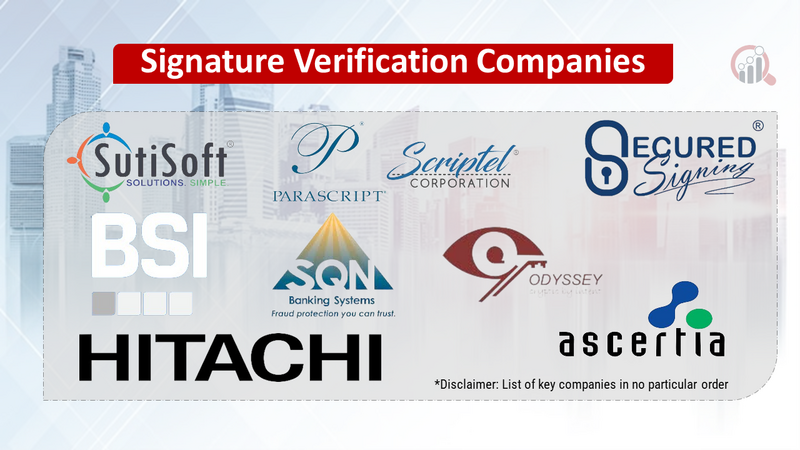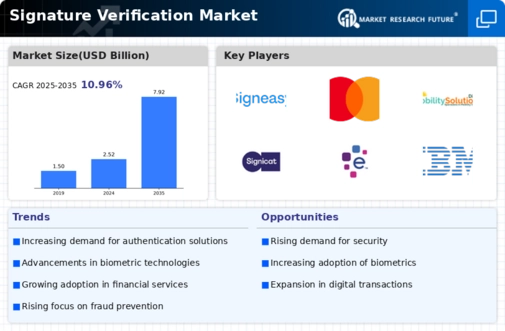Top Industry Leaders in the Signature Verification Market

Signature Verification Market: Dive into the Latest News and Updates
In today's digital world, secure authentication is paramount. Signature verification has transformed from manually scrutinizing penmanship to a sophisticated blend of technology and algorithms, safeguarding transactions, contracts, and sensitive documents.
Some of Signature Verification Companies Listed Below:
- DynaSig of USA
- Crypt of the United Kingdom
- Secured Signing of New Zealand
- Ascertia of the United Kingdom
- Odyssey Technologies of India
- Parascript of the United States
- Hitachi of Japan
Strategies Fueling Growth:
-
Focus on Mobile Accessibility and Cloud Deployment: Offering cloud-based signature verification solutions with mobile app integrations caters to the increasing shift towards remote work and digital transactions. -
Integration with Existing Systems and Documents: Signature verification platforms that seamlessly integrate with existing document management systems, workflow tools, and e-signature software streamline operations and simplify adoption. -
Advanced Algorithms and AI-powered Fraud Detection: Implementing machine learning and AI for signature analysis, anomaly detection, and real-time fraud prevention enhances security and accuracy, mitigating fraudulent signing attempts. -
Compliance and Regulatory Considerations: Adhering to industry regulations and data privacy laws builds trust and ensures compatibility with existing legal frameworks, particularly relevant for financial institutions and healthcare organizations.
Market Share Decoding: Key Factors to Consider:
-
Technology and Feature Set: Companies offering diverse verification methods, including online, offline, biometric analysis, and AI-powered algorithms, cater to wider needs and attract larger customer bases. -
Industry Expertise and Compliance Focus: Providers with deep understanding of specific industries and their compliance requirements can tailor solutions for optimal security within those sectors, gaining an edge in niche markets. -
Scalability and Integration Capabilities: Signature verification platforms offering flexible deployment options, easy integration with existing systems, and the ability to handle large volumes of documents adapt to organizational growth and future needs. -
User Experience and Ease of Implementation: Intuitive interfaces, clear instructions, and simple workflow integrations minimize user training requirements and facilitate broader adoption within organizations.
New and Emerging Stars: Illuminating the Verification Path:
-
Multi-modal Authentication and Continuous Monitoring: Startups like Pindrop and BioCatch combine signature verification with other biometric modalities like voice analysis and behavioral patterns, creating a more robust authentication layer and enabling continuous fraud detection. -
Blockchain-Based Secure Signature Storage and Verification: Companies like Evernym and Civic explore blockchain technology for tamper-proof storage of signed documents and decentralized verification protocols, aiming to eliminate document forgery and enhance trust in online transactions. -
AI-powered Forgery Detection and Deep Learning Techniques: Startups like Deeptrace and Truepicle utilize AI and deep learning algorithms to analyze complex signature features and identify synthetic forgeries, enhancing the accuracy and security of signature verification.
Latest Company Updates:
October 25, 2023:
-
Focus on biometric signature verification: Utilizing fingerprints, iris scans, or voice analysis for improved accuracy and security.
November 18, 2023:
-
Advanced AI and machine learning algorithms deployed for signature verification: Improving accuracy, detecting forgeries, and adapting to evolving signature styles. -
Focus on cloud-based signature verification solutions: Offering scalability, accessibility, and ease of deployment.
December 9, 2023:
-
International Organization for Standardization (ISO) updates signature verification standards: Streamlining procedures and enhancing global compatibility. -
Focus on mobile-based signature verification apps: Convenient and secure signing for digital documents on the go.
January 8, 2024:
-
Integration with blockchain technology for tamper-proof signature verification: Ensuring document authenticity and preventing fraudulent modifications. -
Focus on user education and awareness: Ensuring secure signing practices and recognizing potential fraudulent techniques.
January 10, 2024:
-
Rise of remote authentication and onboarding processes: Signature verification enables secure document signing without physical presence. -
Focus on ethical considerations and responsible use of AI in signature verification: Mitigating bias, ensuring transparency, and protecting user privacy.









